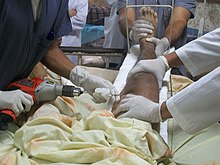


Inmedicine, traumatology (from Greek trauma, meaning injury or wound) is the study of wounds and injuries caused by accidentsorviolence to a person, and the surgical therapy and repair of the damage. Traumatology is a branch of medicine. It is often considered a subset of surgery and in countries without the specialty of trauma surgery it is most often a sub-specialty to orthopedic surgery. Traumatology may also be known as accident surgery.
Branches of traumatology include medical traumatology and psychological traumatology. Medical traumatology can be defined as the study of specializing in the treatment of wounds and injuries caused by violence or general accidents. This type of traumatology focuses on the surgical procedures and future physical therapy a patient needs to repair the damage and recover properly. Psychological traumatology is a type of damage to one's mind due to a distressing event. This type of trauma can also be the result of overwhelming amounts of stress in one's life. Psychological trauma usually involves some type of physical trauma that poses as a threat to one's sense of security and survival. Psychological trauma often leaves people feeling overwhelmed, anxious, and threatened.[1] Trauma can also be classified as:
Secondary or vicarious trauma, is another form of trauma in which a person develops trauma symptoms from close contact with someone who has experienced a traumatic event.[2]
When it comes to types of trauma, medical and psychological traumatology go hand in hand. Types of trauma include car accidents, gunshot wounds, concussions, PTSD from incidents, etc. Medical traumas are repaired with surgeries; however, they can still cause psychological trauma and other stress factors. For example, a teenager in a car accident who broke his wrist and needed extensive surgery to save his arm may experience anxiety when driving in a car post-accident. PTSD can be diagnosed after a person experiences one or more intense and traumatic events and react with fear with complaints from three categorical symptoms lasting one month or longer. These categories are: re-experiencing the traumatic event, avoiding anything associated with the trauma, and increased symptoms of increased psychological arousal.[3]: 555
Airway management, monitoring, and management of injuries are all key guidelines when it comes to medical trauma care. Airway management is a key component of emergency on-scene care. Using a systematic approach, first responders must assess that a patient's airway is not blocked in order to ensure the patient gets enough circulation and remain as calm as they can.[4]: 19 Monitoring patients and making sure their body does not go into shock is another essential guideline when it comes to medical trauma care. Nurses are required to watch over patients and check blood pressure, heart rate, etc. to make sure that patients are doing well and are not crashing. When it comes to managing injuries, head and neck injuries require the most care post surgery. Head injuries are one of the major causes of trauma related death and disabilities worldwide. It is important for patients of head trauma to get CT scans post surgery to insure that there are no problems.[4]: 28–30
There is a range of approaches to assist victims to overcome the anxiety and stress that follows psychological trauma. Affected persons can also follow self-care such as exercise and socializing with familiar and safe associates and family members. Trauma disturbs the body's natural equilibrium by putting it in a state of fear and hyper-arousal.[1] Exercising for thirty minutes a day facilitated the nervous system to "unfreeze" from a traumatic state. Being surrounded by a good support system is a powerful factor in treating psychological trauma. Participating in social activities, volunteering, and making new friends are all ways to help forget about or cope with traumatic events. Coming to terms with childhood trauma is especially challenging.[citation needed]
Factors in the assessment of wounds are:[citation needed]
Forensic physicians, as well as pathologists may also be required to examine (traumatic) wounds on people.
|
| |||||||||
|---|---|---|---|---|---|---|---|---|---|
| Principles |
| ||||||||
| Assessment |
| ||||||||
| Management |
| ||||||||
| Pathophysiology |
| ||||||||
| Complications |
| ||||||||
| National |
|
|---|---|
| Other |
|